Excavation Contractors Rancho Murieta
Top 10 Excavation Contractor in Rancho Murieta
Get 3 FREE Excavation Company Near Me quotes for your project today! Compare profiles, reviews, accreditations, portfolio, etc... and choose the best deal.
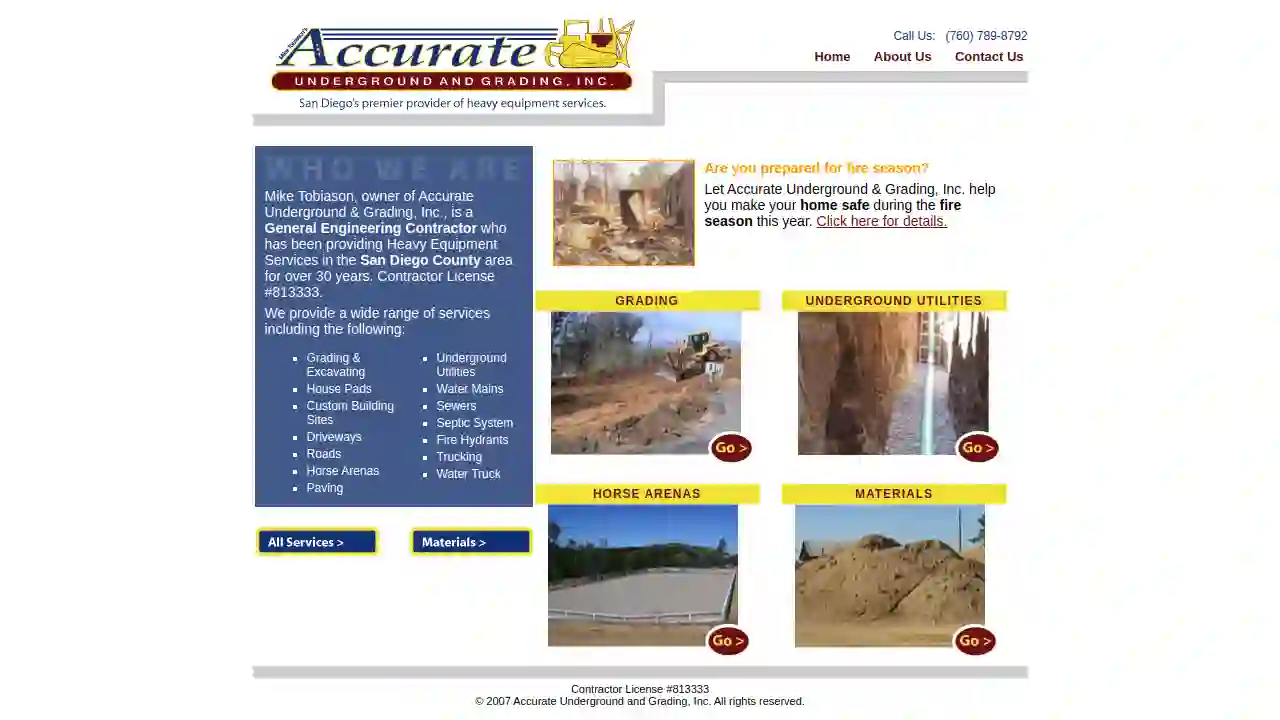
Accurate Underground & Grading
51 reviews1315 Walnut Street, Ramona, 92065, USAbout Us Accurate Underground & Grading, Inc. is a family-owned and operated business that has been serving the San Diego County area for over 30 years. Owner Mike Tobiason is a General Engineering Contractor with over 30 years of experience in the industry. Mike was born and raised in Ramona and started working with his father Angus at a young age. He learned the trade from the ground up, operating equipment and installing septic systems. In 1982, Mike started his own business, Accurate Underground & Grading, Inc. Since then, the company has grown into a thriving mid-sized excavating company, providing a wide range of services to residential and commercial clients. Our Commitment to the Community Accurate Underground & Grading, Inc. is committed to giving back to the community. We support many different community events, including the Ramona Boys & Girls Club, Grad-Nite, the Ramona Jr. Fair & Livestock Auction, Ramona Pony Baseball, Ramona Girls Softball, Poway Girls Softball, the Ramona 4th of July Fireworks, and the Ramona Lutheran School Playground. Our Team Mike and his team are dedicated to providing high-quality services to their clients. They are committed to safety, efficiency, and customer satisfaction. Accurate Underground & Grading, Inc. is a company that you can trust to get the job done right.
- Services
- Why Us?
- Our Team
- Gallery
Get Quote
Southern California Construction Development Inc
52 reviewsIrvine, USTeam Trust Commitment SOUTHERN CALIFORNIA CONSTRUCTION DEVELOPMENT 南加州建筑开发工程公司秉承着以最专业的团队,提供最一流的服务. 通过我们的一砖一瓦为城市增添全新的风景线。无论是住宅的翻新, 还是商业大楼的全新开发, 我们都有着值得信赖的专业, 优秀的团队, 及专业的技术, 确保每一个工程的品质。 MISSION 团队合作我们相信公司最大的资产就是员工,和客户像一个团队般的合作,因为我们认为双方对等的信任才是成功最大的关键。诚信原则忠於品质、诚实和勤奋,拥有业界最高道德标准,坚持做对的事情,打造一家以信任为基础的公司,秉持高标准的服务品质,尤其注重对于客户的诚信,打造不可取代性。长久承诺相信和客戶的长久关系是公司的根本命脈,积极的付出及精准的市场分析,把握机遇使我们与众不同。我们承诺,我们视每一位客户为"尊敬的朋友"。
- Services
- Why Us?
- Our Team
- Gallery
Get Quote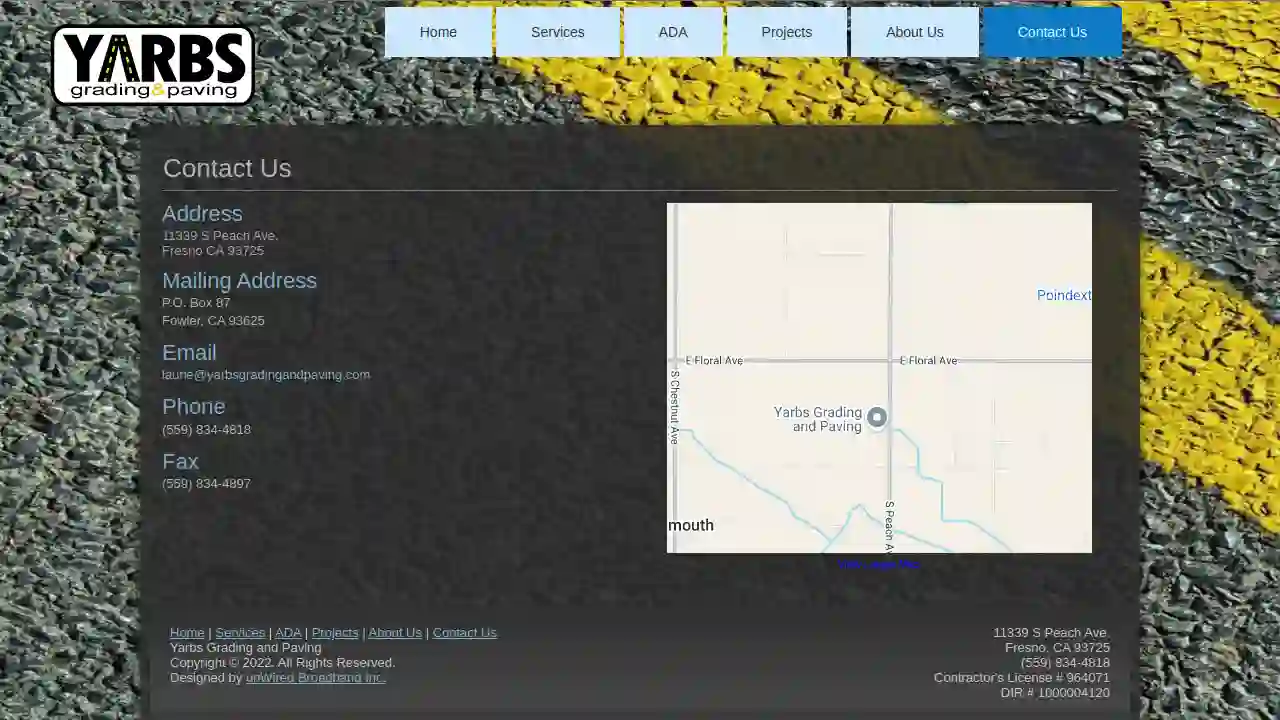
Yarbs Grading and Paving
55 reviews11339 S Peach Ave., Fresno, 93725, USYarbs Grading and Paving: Your Trusted Partner for Quality Construction Yarbs Grading and Paving is a full-service grading and paving company located in Fresno, California. We have over 20 years of experience and are committed to delivering quality projects that meet or exceed our customers' expectations. We specialize in parking lot construction, ADA improvements, and city, county, and state roadway construction. Our team is dedicated to providing exceptional service and ensuring that every project is completed on time and within budget. We take pride in our work and strive to build lasting relationships with our clients. We offer a wide range of services, including: Concrete improvements Asphalt paving and overlays Mass excavation Underground Demolition Seal coating Striping We serve Fresno, Clovis, Madera, and the surrounding areas. Contact us today to discuss your project needs.
- Services
- Why Us?
Get Quote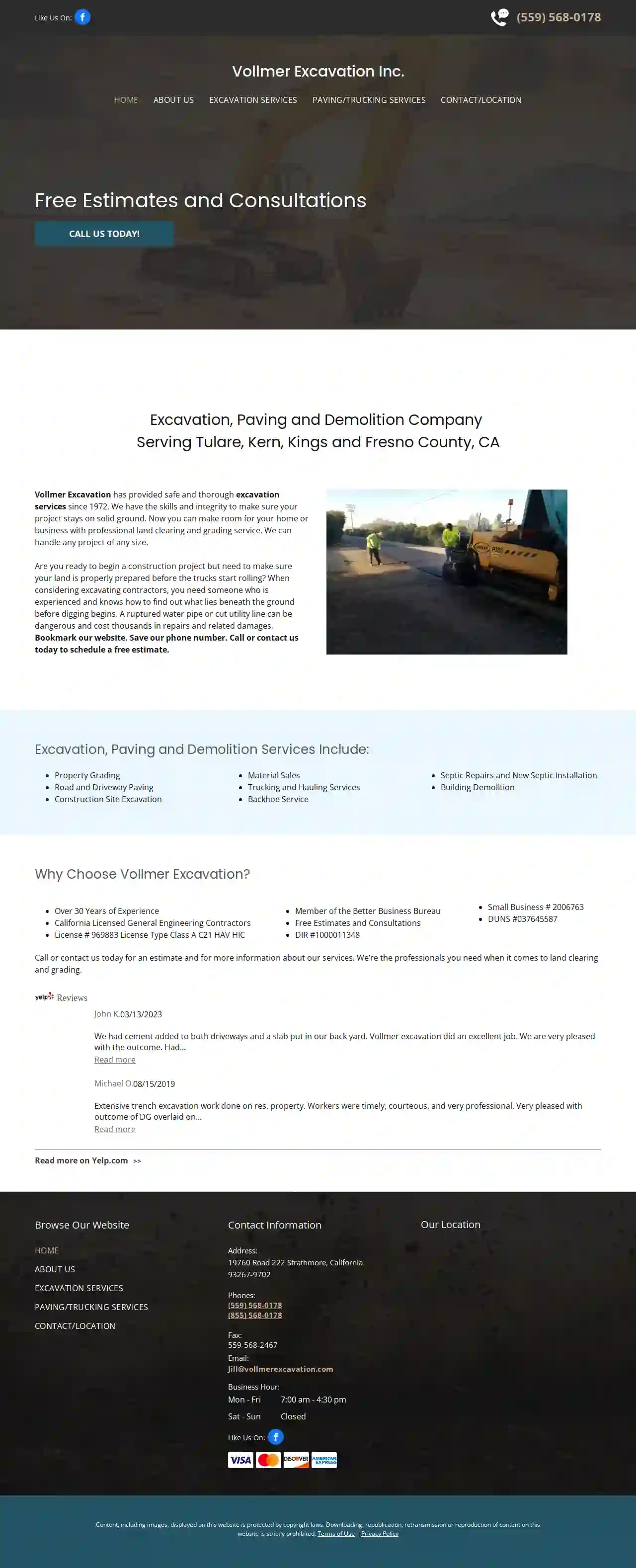
Vollmer Excavation
511 reviews19760 Road 222, Strathmore, 93267-9702, USAbout Vollmer Excavation Since 1972, Robert Vollmer started his one-man business in Tulare County. He began with a backhoe service, providing services for farming operations, construction jobs, and septic system repairs. After several years, he expanded his services to include swimming pool excavation, dump truck service, and material sales. Over the years, the business has grown and expanded its services throughout the Central Valley. Vollmer Excavation believes no job is too small. Contact our office for a free estimate. We provide all types of earthwork, road construction, residential and commercial projects, asphalt paving, demolition, septic tank repairs and installation, backhoe and trucking services, and material sales. Contact us with any questions regarding the type of work we do, and we will be more than happy to provide you with an estimate for service. Why Choose Vollmer Excavation? Over 30 Years of Experience California Licensed General Engineering Contractors License # 969883 License Type Class A C21 HAV HIC Member of the Better Business Bureau Free Estimates and Consultations History of Vollmer Excavation: Bob was born and raised in the Lindsay, California area. His family lived in the foothills of Lindsay where they worked together. Bob and his siblings would go to school and after they returned home they worked with their parents, packing fruit, caring for the family ranch, and working in the family granite pit. In the 1970’s, Bob worked at the local creamery doing maintenance on their equipment. An acquaintance of his stopped by to let him know that he had a backhoe for sale and wanted to know if Bob knew of anyone who may be interested. The backhoe was really worn out, but Bob thought he could repair it and sell it for a small profit. Friends and neighbors started asking him to do some work for them before he sold his backhoe. Of course, he wasn’t going to say no, one small job led to another and before he knew it he had his own backhoe business. Bob ran the old Ford Major backhoe for about a year and a half until the boom broke in half. He upgraded to a newer machine and landed a nice contract with a swimming pool company digging pools. When a different swimming pool contractor-asked for his services it was time to start hiring help. This small one-man business has grown to 25 employees today, one employee recently retired being one of the original employees starting in 1972 and worked with him until 2013, a total of 41 years! Bob’s employees are more than just employees to him, they are friends, family. To this day Bob still has some of his original customers. It is very important to him to take care of his customers and to make sure they are happy. He has made many emergency, middle of the night runs for his customers, anything from pulling a truck out of the mud to repairing a broken pipeline. We can honestly say his work is his life, he loves to work and to help people. Bob has made a great name for himself in the Central Valley and for very good reason!
- Services
- Why Us?
- Gallery
Get Quote
F & K Martins Pavers
4.967 reviewsOakland, USFK Martin Pavers: Your Trusted Brick & Travertine Paver Professionals FK Martin Pavers is your go-to source for all your brick and travertine paver needs in Fort Lauderdale. We are a team of experienced and licensed professionals dedicated to providing high-quality installations and repairs for a wide range of projects, including driveways, patios, pool decks, retaining walls, and more. We take pride in our craftsmanship and attention to detail, ensuring that every project is completed to the highest standards. Our commitment to customer satisfaction is evident in our dedication to providing personalized service and clear communication throughout the entire process. Whether you're looking to enhance your curb appeal, create a relaxing outdoor oasis, or simply need a reliable repair service, FK Martin Pavers is here to help. Contact us today for a free estimate and let us bring your vision to life.
- Services
- Why Us?
- Gallery
Get Quote
JS Company Inc. - Js Co.
53 reviewsBrentwood, USABOUT JS COMPANY AN AFFORDABLE CONTRACTOR YOU CAN TRUST JS Co. is a locally owned, insured and licensed general engineering firm founded in 1998. Its mission is to become your preferred contractor in the San Francisco Bay Area, offering a gamut of services to complete any project. There is no “too small” or “too large” job for us. Count on JS Co. to provide speedy and fair estimates whether you are a homeowner, a business representative, an insurance adjuster or a public official. Our team of friendly and talented professionals is ready to exceed your expectations starting with your initial contact until the completion of your project. Review our strength in numbers and learn more about some of our happy clients in our References section. 0 + YEARS OF EXPERIENCE 0 + PROJECTS COMPLETED 0 + SATISFIED CLIENTS 0 + CONSTRUCTION LICENSES LET JS COMPANY BECOME YOUR PREFERRED CONTRACTOR JS has delivered hundreds of projects to hundreds of clients for over two decades. We look forward to assisting you with your next project. Give us the chance to earn your business! Call Us at 415-460-2100
- Services
- Why Us?
- Testimonials
- Gallery
Get Quote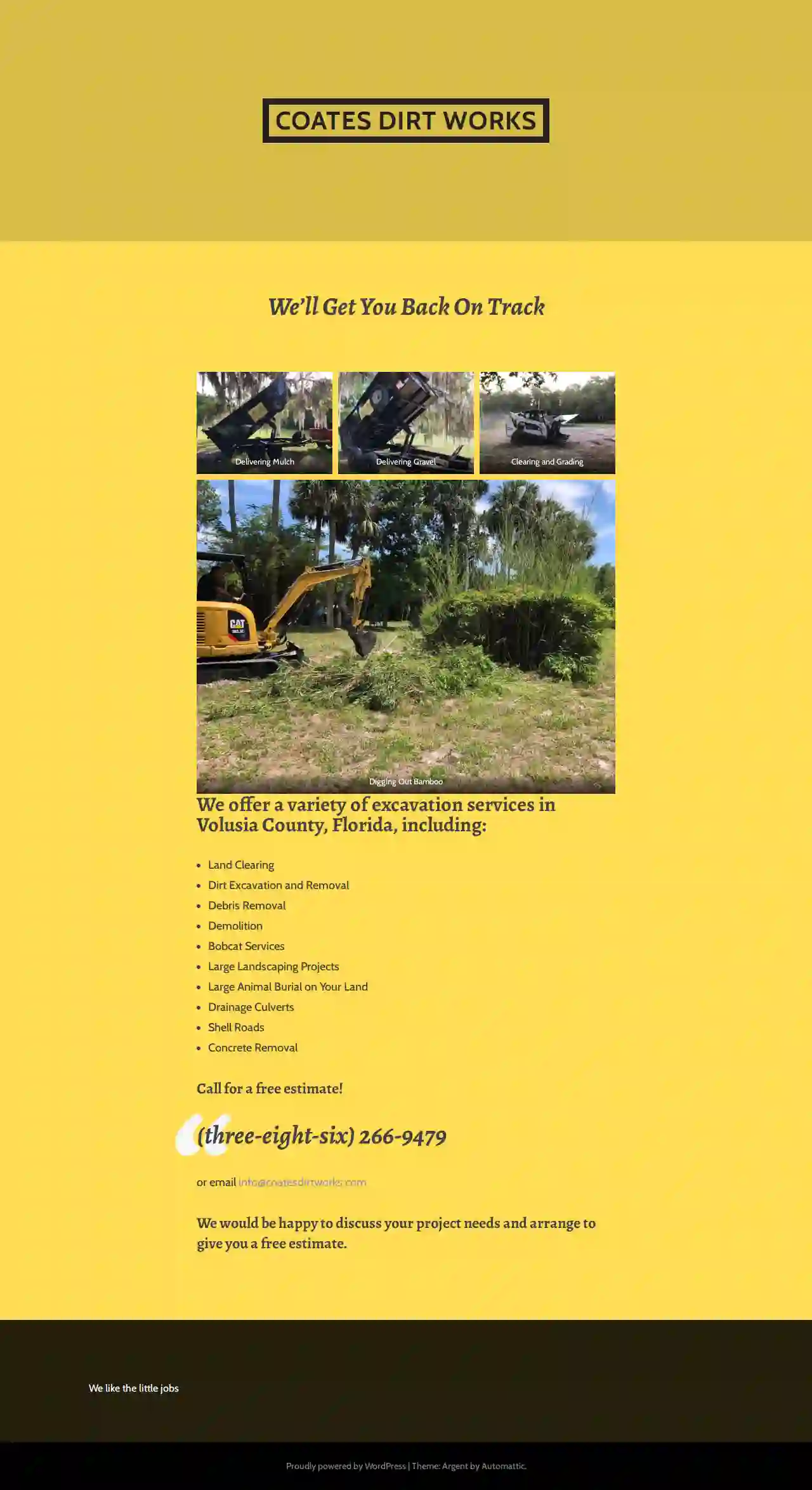
Coates Dirt Works LLC
513 reviewsOrange, USWe'll Get You Back On Track Coates Dirt Works offers a variety of excavation services in Volusia County, Florida, including: Land Clearing Dirt Excavation and Removal Debris Removal Demolition Bobcat Services Large Landscaping Projects Large Animal Burial on Your Land Drainage Culverts Shell Roads Concrete Removal Call for a free estimate! (three-eight-six) 266-9479 or email [email protected] We would be happy to discuss your project needs and arrange to give you a free estimate.
- Services
- Why Us?
- Gallery
Get Quote
Roto-Rooter Plumbing & Water Cleanup
4.8Fort Lauderdale, USYour Local Roto-Rooter Plumber in Fort Lauderdale, FL Need a plumber in Ft. Lauderdale, FL? Roto-Rooter is your trusted choice for drain cleaning, water heater repair, and emergency plumbing needs. Ft. Lauderdale residents and businesses depend on us for plumbing services 24/7, 365 days a year, including holidays. Our experienced plumbers will promptly, affordably, and efficiently address your plumbing concerns. Trusted and recommended since 1935, we are the leading plumbing company in the USA. When you choose Roto-Rooter of Ft. Lauderdale, you can expect the following: Same day service 24/7 availability No hidden or extra charge for plumbing or drain service on holidays, nights, and weekends Free onsite and upfront estimates Professional, experienced plumbers State-of-the-art diagnostics and equipment Senior and military discounts Coupons and financing options available Contact us at 954-735-3879 or use our online scheduling form to arrange an appointment with one of Roto-Rooter's friendly, professional Ft. Lauderdale plumbers.
- Services
- Why Us?
- Testimonials
- Gallery
Get Quote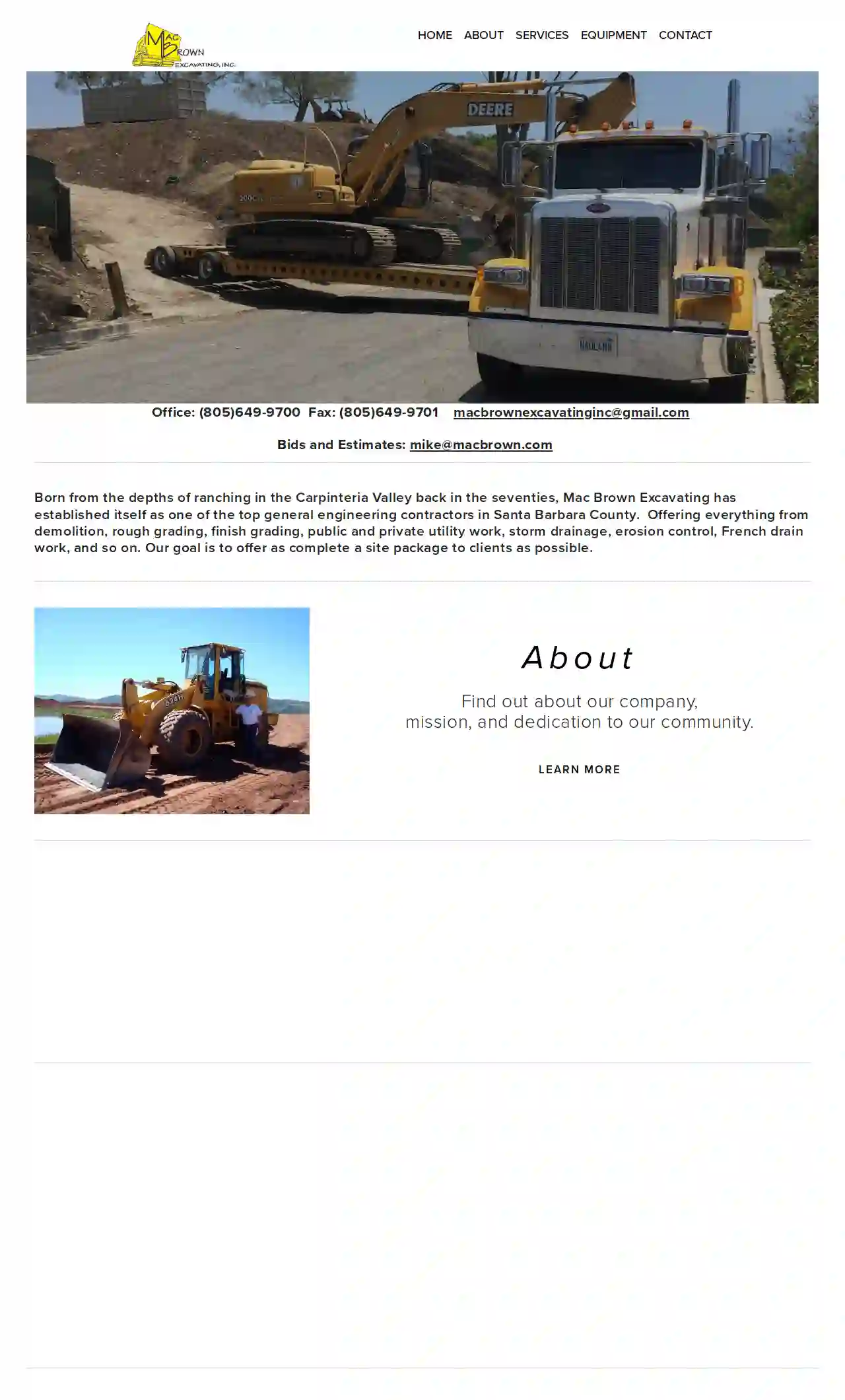
Mac Brown Excavating Inc
56 reviewsP.O. Box 8, Carpinteria, 93014, USMac Brown Excavating, Inc. Born from the depths of ranching in the Carpinteria Valley back in the seventies, Mac Brown Excavating has established itself as one of the top general engineering contractors in Santa Barbara County. Offering everything from demolition, rough grading, finish grading, public and private utility work, storm drainage, erosion control, French drain work, and so on. Our goal is to offer as complete a site package to clients as possible.
- Services
- Why Us?
- Gallery
Get Quote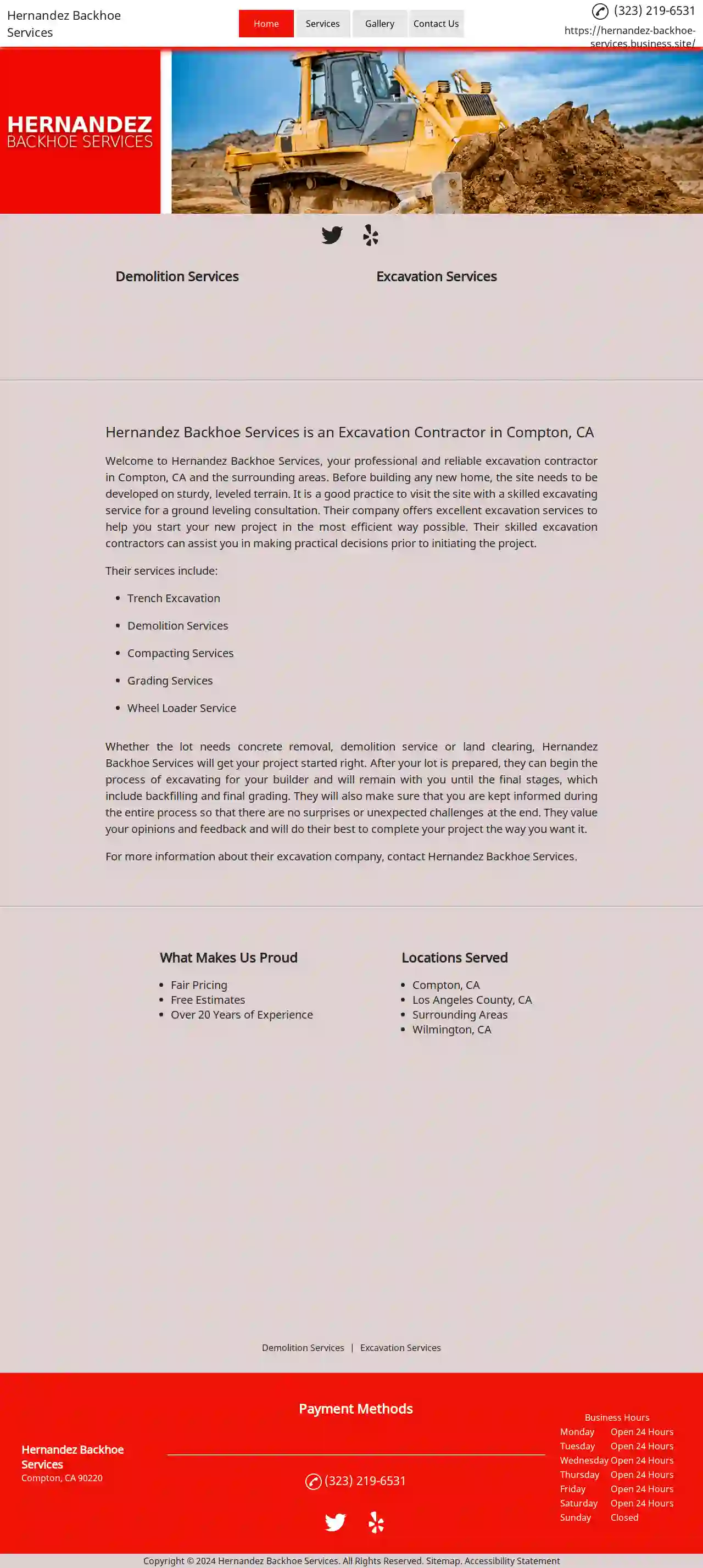
Hernandez Backhoe Services
510 reviewsCompton, 90220, USHernandez Backhoe Services is your go-to excavation contractor in Compton, CA and the surrounding areas. We are dedicated to providing professional and reliable services for all your excavation needs. Before you can build your dream home, you need a solid foundation. That's where we come in. We offer expert ground leveling consultations to ensure your project starts off on the right foot. Our skilled excavation contractors can help you make informed decisions throughout the process, from initial planning to final grading. We offer a comprehensive range of services, including: Trench Excavation Demolition Services Compacting Services Grading Services Wheel Loader Service Whether you need concrete removal, demolition, or land clearing, we'll get your project started right. We'll work closely with your builder throughout the entire process, from excavation to backfilling and final grading. We'll keep you informed every step of the way, ensuring there are no surprises or unexpected challenges. We value your input and feedback and will do our best to complete your project to your satisfaction. For more information about our excavation services, contact Hernandez Backhoe Services today.
- Services
- Why Us?
Get Quote
Over 22,076+ Excavation Contractors in our network
Our excavation providers operate in Rancho Murieta & surroundings!
ExcavationHQ has curated and vetted Top Excavation Pros in and around Rancho Murieta. Find the most reliable contractor today.
Frequently Asked Questions About Excavation Contractors
- Experience: Choose contractors with a proven track record and years of experience in excavation projects similar to yours.
- Licensing and Insurance: Verify that they are properly licensed to operate in your area and carry adequate insurance to protect you from liability in case of accidents or damage.
- Equipment and Resources: Ensure they have the necessary equipment and resources to handle your project efficiently and safely.
- Positive Reviews and References: Check online reviews and testimonials from previous customers. Request references and contact them to inquire about their experience with the contractor.
- Professionalism: Opt for a company that communicates clearly, provides detailed and transparent estimates, and has a responsive and courteous team.
- Sloped Property: Your property has a significant slope, making it prone to soil erosion or landslides.
- Creating Usable Space: You want to level off a sloped area to create a flat surface for patios, gardens, or other outdoor spaces.
- Preventing Damage: Erosion is threatening existing structures, driveways, or walkways.
- Landscaping Features: You're incorporating tiered gardens, raised beds, or other landscaping elements requiring soil retention.
- New Construction: Laying foundations, basements, or underground utilities for new buildings.
- Home Additions: Creating space for new rooms, basements, or extensions.
- Landscaping: Leveling ground, creating slopes, installing retaining walls, or digging for ponds or pools.
- Drainage Improvement: Installing French drains, drainage ditches, or swales to manage water runoff.
- Utility Installation or Repair: Laying new water, sewer, gas, or electrical lines, or repairing existing ones.
- Demolition: Clearing debris and preparing the site after demolishing a structure.
- Clear the Area: Remove any obstacles, including vehicles, outdoor furniture, landscaping features, or structures, from the excavation zone and surrounding area.
- Mark Existing Features: Identify and mark underground utilities, septic tanks, sprinkler systems, or other buried elements you want to protect.
- Protect Landscaping: Use tarps or fencing to shield trees, shrubs, gardens, or other landscaping elements from damage.
- Provide Access: Ensure the excavation contractor has clear access to the work area, including gates wide enough for equipment.
- Discuss Logistics: Coordinate with the contractor regarding parking arrangements, material delivery, and any special instructions or concerns you might have.
How do I find a good excavation contractor?
How do I know if I need a retaining wall?
How do I know if I need excavation for my project?
How do I prepare my property for excavation?
How do I find a good excavation contractor?
- Experience: Choose contractors with a proven track record and years of experience in excavation projects similar to yours.
- Licensing and Insurance: Verify that they are properly licensed to operate in your area and carry adequate insurance to protect you from liability in case of accidents or damage.
- Equipment and Resources: Ensure they have the necessary equipment and resources to handle your project efficiently and safely.
- Positive Reviews and References: Check online reviews and testimonials from previous customers. Request references and contact them to inquire about their experience with the contractor.
- Professionalism: Opt for a company that communicates clearly, provides detailed and transparent estimates, and has a responsive and courteous team.
How do I know if I need a retaining wall?
- Sloped Property: Your property has a significant slope, making it prone to soil erosion or landslides.
- Creating Usable Space: You want to level off a sloped area to create a flat surface for patios, gardens, or other outdoor spaces.
- Preventing Damage: Erosion is threatening existing structures, driveways, or walkways.
- Landscaping Features: You're incorporating tiered gardens, raised beds, or other landscaping elements requiring soil retention.
How do I know if I need excavation for my project?
- New Construction: Laying foundations, basements, or underground utilities for new buildings.
- Home Additions: Creating space for new rooms, basements, or extensions.
- Landscaping: Leveling ground, creating slopes, installing retaining walls, or digging for ponds or pools.
- Drainage Improvement: Installing French drains, drainage ditches, or swales to manage water runoff.
- Utility Installation or Repair: Laying new water, sewer, gas, or electrical lines, or repairing existing ones.
- Demolition: Clearing debris and preparing the site after demolishing a structure.
How do I prepare my property for excavation?
- Clear the Area: Remove any obstacles, including vehicles, outdoor furniture, landscaping features, or structures, from the excavation zone and surrounding area.
- Mark Existing Features: Identify and mark underground utilities, septic tanks, sprinkler systems, or other buried elements you want to protect.
- Protect Landscaping: Use tarps or fencing to shield trees, shrubs, gardens, or other landscaping elements from damage.
- Provide Access: Ensure the excavation contractor has clear access to the work area, including gates wide enough for equipment.
- Discuss Logistics: Coordinate with the contractor regarding parking arrangements, material delivery, and any special instructions or concerns you might have.